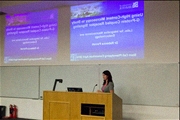Tutor HuntResources Neuroscience Resources
The Endosomal Pathway In Parkinson`s Disease
In this review, we summarized the evidence that a number of Parkinson`s associated genetic mutations or polymorphisms (LRRK2, VPS35, GBA, ATP13A2, ATP6AP2, DNAJC13/RME-8, RAB7L1, GAK) disrupt protein trafficking and degradation via the endosomal pathway and discussed how such defects could arise from or contribute to the accumulation and misfolding of α-synuclein in Lewy bodies.
Date : 22/03/2016
Author Information

Uploaded by : Rebecca
Uploaded on : 22/03/2016
Subject : Neuroscience
Parkinson's disease is primarily a movement disorder with predilection for the nigral dopaminergic neurons and is often associated with widespread neurodegeneration and diffuse Lewy body deposition. Recent advances in molecular genetics and studies in model organisms have transformed our understanding of Parkinson's pathogenesis and suggested unifying biochemical pathways despite the clinical heterogeneity of the disease. In this review, we summarized the evidence that a number of Parkinson's associated genetic mutations or polymorphisms (LRRK2, VPS35, GBA, ATP13A2, ATP6AP2, DNAJC13/RME-8, RAB7L1, GAK) disrupt protein trafficking and degradation via the endosomal pathway and discussed how such defects could arise from or contribute to the accumulation and misfolding of -synuclein in Lewy bodies. We propose that an age-related pathological depletion of functional endolysosomes due to neuromelanin deposition in dopaminergic neurons may increase their susceptibility to stochastic molecular defects in this pathway and we discuss how enzymes that regulate ubiquitin signaling, as exemplified by the ubiquitin ligase Nedd4, could provide the missing link between genetic and acquired defects in endosomal trafficking. This article is part of a Special Issue entitled 'Neuronal Protein'.
This resource was uploaded by: Rebecca
